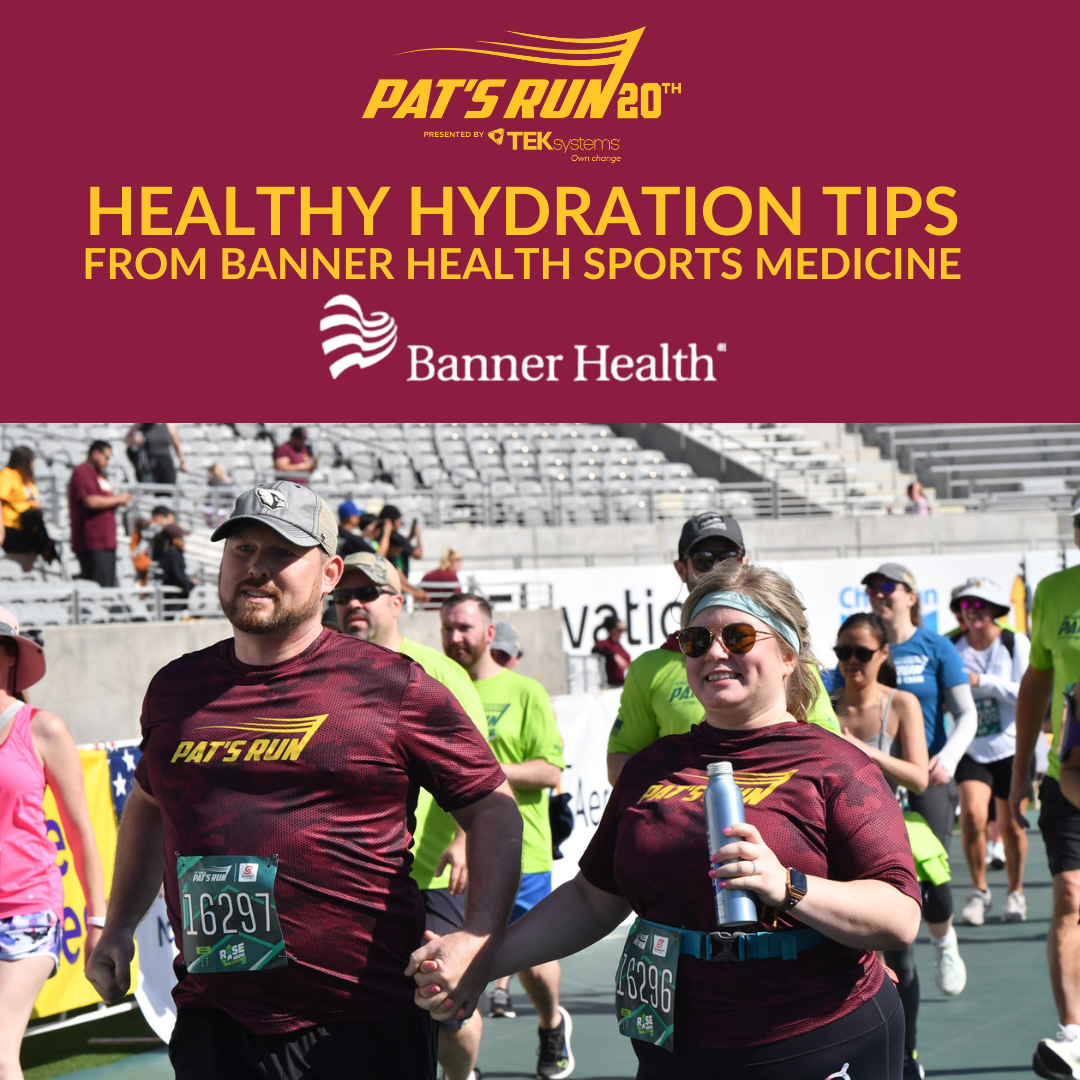Healthy Hydration for Pat’s Run
by Dan Casey, MD, Amy Overlin, MD and Karla Wright, RD, CSSD of Banner Health
If you’ve been a runner for a long time or are new to racing, learning to avoid dehydration is an important skill and can be potentially dangerous if ignored. With water making up 60-70% of the human body, many of the body’s vital functions—from transportation of nutrients to maintaining blood pressure —are directly dependent on our hydration status. Yet, did you know that losing 1-2% of our total body fluid, (that’s up to three pounds of water weight for someone weighing 150 pounds), can have a negative effect on your performance and cause you to feel more fatigued during your activity? Research has shown that hydration is one of the best predictors of performance. With that said, let’s look at some of the key aspects of staying hydrated to keep you moving and most importantly safe on the path to completing Pat’s Run.
Your number one tool against dehydration is PRE-hydration. Research suggests an athlete should pre-hydrate with water approximately two to four hours before a race to ensure proper hydration, approximately two to four milliliters per pound of body weight, or 10-20 ounces for someone weighing 150 pounds.
Another important tool in preventing dehydration is to monitor your fluid status. So how can you monitor your hydration? First and foremost, it’s important to recognize that your thirst mechanism typically kicks in well after you have reached mild dehydration levels. Therefore, the easiest and most straightforward way to track your hydration level is to monitor your urine. When you become dehydrated, your kidneys go through a series of steps to hold on to more water for the body. This results in a smaller amount of darker yellow urine and thus a less frequent need to urinate.
Use the following tips:
- Your urine should not change the color of the water in the toilet bowl or your urine should be a very light-yellow color
- You should need to urinate every two to three hours throughout the day.
- You should not notice a decrease in your urine output after exercising.
- Once you feel thirsty, you are already behind the eight ball, and should increase your water intake while avoiding alcohol and caffeine
We all respond differently to exercise, disperse heat at different rates and even sweat different amounts when we are active. So ultimately, the amount you drink during or even after a race will be dependent on your bodies’ unique needs. Basic research suggests runners drink 8-24 ounces per hour; however, it is better to track your own losses and add or subtract water based on your sweat rate to prevent hydration complications.
One effective strategy is weigh yourself without clothing before and after each run. This prevents your sweaty, post-run clothes from artificially elevating your weight. For every pound of weight lost, you need to drink at least 20 ounces of water. Yes, 20 ounces! If you lose more than 2% of your body weight, for example, more than three pounds if you weigh 150 pounds, you’ll need to increase your water intake during your run. This will also help you get used to training with water in your stomach while minimizing the negative effects of dehydration. Another important note: If you continue to sweat after you finish your run make sure you add a modest amount of extra fluid to your total post-run hydration to account for the continued fluid loss.
As far as what to drink, there has been a lot of research and marketing addressing what liquids are best to drink and when. If your race or practice lasts less than one hour, drinking plain water is an excellent choice. If your race is longer than one hour, a drink containing carbohydrates and sodium is a good option. Sports drinks have made quite a name for themselves trying to meet this need. Research shows performance improves with the addition of carbohydrates and salt, particularly for longer races and sports. The carbohydrates from sports drinks provides a fuel source as well as increasing the absorption of the fluid within the gut. The sodium helps our body to hold on to the water and decreases the amount we excrete in the urine as well as replacing the sodium we lose in our sweat. In addition, the salt in the fluid helps to stimulate our body’s thirst drive encouraging us to drink more fluids.
Hydration also prevents heat-related illnesses and other complications. Exercise uses energy to power our muscles, which generates heat. The harder you work, the more heat is generated. As you generate more heat, you begin to sweat. As the air evaporates the sweat, the skin surface cools. These actions prevent your body temperature from dangerously increasing. By drinking fluids before, during and after exercise we maintain our ability to produce sweat and maintain our blood flow to our skin. Both these adaptations help to prevent heat-related illness and complications.
Adequate hydration has numerous benefits, but don’t drag your feet on getting started. The kidneys require two weeks to adjust to better hydration techniques, so if you wait until race day, you are already too late to reap many of the benefits. Start now and make it a part of your training program. You have the knowledge to train safer, harder and improve your competitive edge all through maximizing your hydration. Apply your knowledge and happy training runners!




